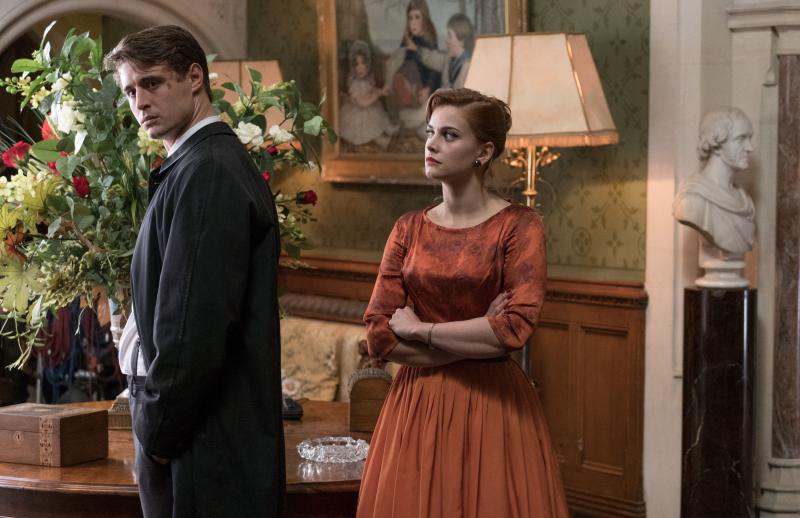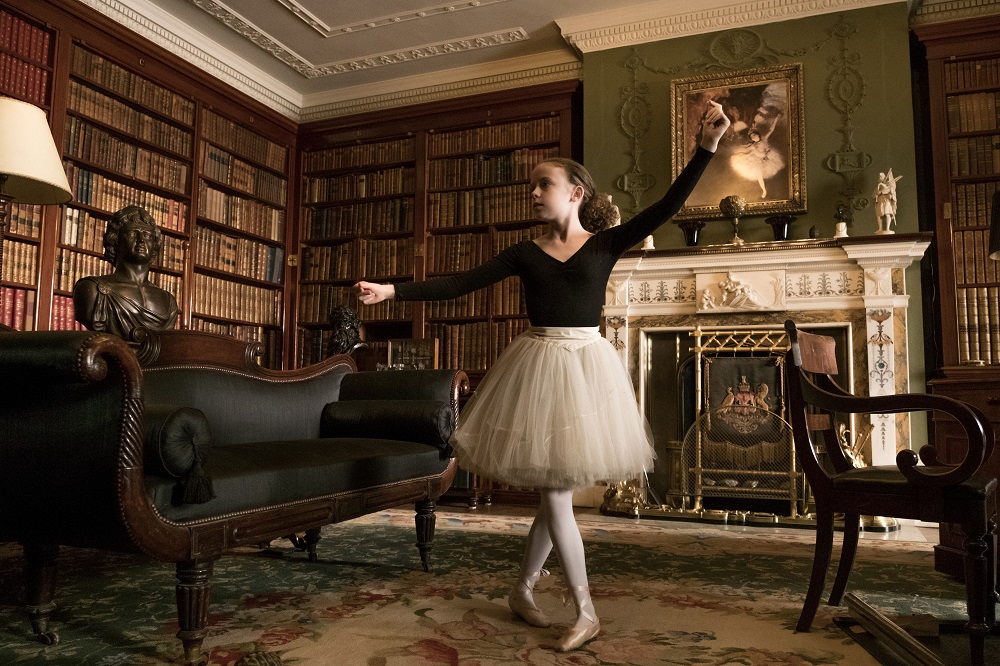Agatha Christie's Crooked House, Channel 5 review - actresses chew furniture for fun | reviews, news & interviews
Agatha Christie's Crooked House, Channel 5 review - actresses chew furniture for fun
Agatha Christie's Crooked House, Channel 5 review - actresses chew furniture for fun
Country house murder mystery stars a family from hell and an unlikely culprit

Crooked House is being released as a film in various territories, but has already been shown on television in America and has now surfaced as a drama on Channel 5 bearing the title Agatha Christie’s Crooked House.
Adapted from the novel published in 1949, the plot of Crooked House adheres to the model of Christie’s two most famous titles, The Mousetrap and Murder on the Orient Express: someone has been done away with, and everyone in situ has a plausible motive. In this case the victim was Aristide Leonides, a wealthy patriarch of Greek immigrant stock who had a finger in any number of pies – helping the CIA with their anti-communist work, funding Vegas nightclubs, while creating a vast business empire called Associated Catering – all of them entertaining distractions which turned out to have no bearing on his murder. The titular residence was home to a dysfunctional family of Leonides dependents almost all of whom hoped to be beneficiaries of his elusive will. They included his latest wife, a pneumatic American dancer Brenda (Christina Hendricks), whom he quietly allowed to canoodle with his grandson’s young tutor (John Heffernan). Then there were his two sons and their ghastly wives: historian/gambler Philip (Julian Sands) hoped for his father’s patronage to greenlight a film script in which his alcoholic wife Magda (Gillian Anderson) could resurrect her career. Weak-willed Roger (Christian McKay) had made a hash of the family business and hoped to do good works in a Barbadian orphanage with his childless wife Clemency (Amanda Abbington).
The titular residence was home to a dysfunctional family of Leonides dependents almost all of whom hoped to be beneficiaries of his elusive will. They included his latest wife, a pneumatic American dancer Brenda (Christina Hendricks), whom he quietly allowed to canoodle with his grandson’s young tutor (John Heffernan). Then there were his two sons and their ghastly wives: historian/gambler Philip (Julian Sands) hoped for his father’s patronage to greenlight a film script in which his alcoholic wife Magda (Gillian Anderson) could resurrect her career. Weak-willed Roger (Christian McKay) had made a hash of the family business and hoped to do good works in a Barbadian orphanage with his childless wife Clemency (Amanda Abbington).
Then there was a granddaughter, Sophia (Stefanie Martini), who from her time in Cairo during the war happened to be an old flame of the private detective Charles Hayward (Max Irons) summoned to investigate the case on behalf of Scotland Yard. The task of penetrating this cat’s cradle of mutually assured enmities fell to Hayward, working undercover at the bidding of a grizzled inspector from Scotland Yard (Terence Stamp). As he went about his business he even briefly became a suspect himself as a result of his sizzling/fizzling on-off love affair with Olivia. Meanwhile the deceased’s sister-in-law Lady Edith (Glenn Close, pictured above) took on the burden of caring for Josephine (Honor Kneafsey, pictured below), the dangerously neglected and fearfully intelligent young daughter of Philip and Magda who thought of herself as a budding detective. The adaptation was by Julian Fellowes, whose kitemark could be discerned in casual snobbery (“Haemophiliacs are little bleeders, like some European royals”) and cloth-eared dialogue (“We're a very odd family. There’s a ruthlessness in us, and different kinds of ruthlessness”). His gift for dinner party scenes, so often roadtested in Downton Abbey, was deftly deployed in a toe-curling dinner-from-hell centrepiece in which all the suspects are gathered round the table and fail to make polite conversation.
The adaptation was by Julian Fellowes, whose kitemark could be discerned in casual snobbery (“Haemophiliacs are little bleeders, like some European royals”) and cloth-eared dialogue (“We're a very odd family. There’s a ruthlessness in us, and different kinds of ruthlessness”). His gift for dinner party scenes, so often roadtested in Downton Abbey, was deftly deployed in a toe-curling dinner-from-hell centrepiece in which all the suspects are gathered round the table and fail to make polite conversation.
None of the characters who were meant to be related looked anything like one another. The three American actresses all competed to see who could chew the most furniture: Close as a stately English galleon, Anderson as a camp dipsomaniac with a Cleopatra hairdo and Hendricks working through a repertoire of breathy Monroesque pouts. Irons, who looks like Daniel Radcliffe’s taller brother, will be able to tell his grandchildren he stood his ground with all of them with one hand tied behind his back (his character being quite dull).
The outcome of the whodunnit is known to those who know, but for all the many red herrings and MacGuffins, a smattering of hints were dropped that the clever culprit would emerge from the left field. The director Gilles Paquet-Brenner, best known for the French film Sarah’s Key, used shakycam, fast cutting and strange angles to ensure that this didn’t look too generically like yet another country house murder mystery. Some of the design details were sleekly done: the safe hiding behind a photograph of Leonides and Her Majesty; Josephine attempting to dance like the ballerina in the Degas canvas on the wall. Those of us who struggle to get the point of ballet must hope not to come to a similar end.
rating
Share this article
Add comment
The future of Arts Journalism
You can stop theartsdesk.com closing!
We urgently need financing to survive. Our fundraising drive has thus far raised £49,000 but we need to reach £100,000 or we will be forced to close. Please contribute here: https://gofund.me/c3f6033d
And if you can forward this information to anyone who might assist, we’d be grateful.

Subscribe to theartsdesk.com
Thank you for continuing to read our work on theartsdesk.com. For unlimited access to every article in its entirety, including our archive of more than 15,000 pieces, we're asking for £5 per month or £40 per year. We feel it's a very good deal, and hope you do too.
To take a subscription now simply click here.
And if you're looking for that extra gift for a friend or family member, why not treat them to a theartsdesk.com gift subscription?
more TV
 The Diplomat, Season 3, Netflix review - Ambassador Kate Wyler becomes America's Second Lady
Soapy transatlantic political drama keeps the Special Relationship alive
The Diplomat, Season 3, Netflix review - Ambassador Kate Wyler becomes America's Second Lady
Soapy transatlantic political drama keeps the Special Relationship alive
 The Perfect Neighbor, Netflix review - Florida found-footage documentary is a harrowing watch
Sundance winner chronicles a death that should have been prevented
The Perfect Neighbor, Netflix review - Florida found-footage documentary is a harrowing watch
Sundance winner chronicles a death that should have been prevented
 Murder Before Evensong, Acorn TV review - death comes to the picturesque village of Champton
The Rev Richard Coles's sleuthing cleric hits the screen
Murder Before Evensong, Acorn TV review - death comes to the picturesque village of Champton
The Rev Richard Coles's sleuthing cleric hits the screen
 Black Rabbit, Netflix review - grime and punishment in New York City
Jude Law and Jason Bateman tread the thin line between love and hate
Black Rabbit, Netflix review - grime and punishment in New York City
Jude Law and Jason Bateman tread the thin line between love and hate
 The Hack, ITV review - plodding anatomy of twin UK scandals
Jack Thorne's skill can't disguise the bagginess of his double-headed material
The Hack, ITV review - plodding anatomy of twin UK scandals
Jack Thorne's skill can't disguise the bagginess of his double-headed material
 Slow Horses, Series 5, Apple TV+ review - terror, trauma and impeccable comic timing
Jackson Lamb's band of MI5 misfits continues to fascinate and amuse
Slow Horses, Series 5, Apple TV+ review - terror, trauma and impeccable comic timing
Jackson Lamb's band of MI5 misfits continues to fascinate and amuse
 Coldwater, ITV1 review - horror and black comedy in the Highlands
Superb cast lights up David Ireland's cunning thriller
Coldwater, ITV1 review - horror and black comedy in the Highlands
Superb cast lights up David Ireland's cunning thriller
 Blu-ray: The Sweeney - Series One
Influential and entertaining 1970s police drama, handsomely restored
Blu-ray: The Sweeney - Series One
Influential and entertaining 1970s police drama, handsomely restored
 I Fought the Law, ITVX review - how an 800-year-old law was challenged and changed
Sheridan Smith's raw performance dominates ITV's new docudrama about injustice
I Fought the Law, ITVX review - how an 800-year-old law was challenged and changed
Sheridan Smith's raw performance dominates ITV's new docudrama about injustice
 The Paper, Sky Max review - a spinoff of the US Office worth waiting 20 years for
Perfectly judged recycling of the original's key elements, with a star turn at its heart
The Paper, Sky Max review - a spinoff of the US Office worth waiting 20 years for
Perfectly judged recycling of the original's key elements, with a star turn at its heart
 The Guest, BBC One review - be careful what you wish for
A terrific Eve Myles stars in addictive Welsh mystery
The Guest, BBC One review - be careful what you wish for
A terrific Eve Myles stars in addictive Welsh mystery
 theartsdesk Q&A: Suranne Jones on 'Hostage', power pants and politics
The star and producer talks about taking on the role of Prime Minister, wearing high heels and living in the public eye
theartsdesk Q&A: Suranne Jones on 'Hostage', power pants and politics
The star and producer talks about taking on the role of Prime Minister, wearing high heels and living in the public eye

Comments
What make of car was driven
The car driven by Max Irons